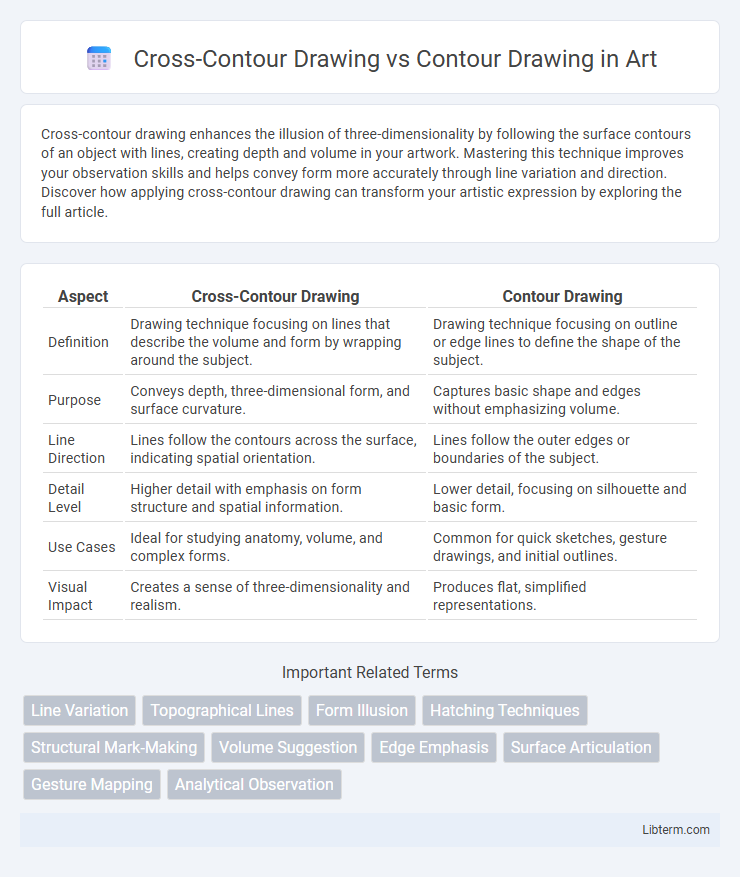Cross-contour drawing enhances the illusion of three-dimensionality by following the surface contours of an object with lines, creating depth and volume in your artwork. Mastering this technique improves your observation skills and helps convey form more accurately through line variation and direction. Discover how applying cross-contour drawing can transform your artistic expression by exploring the full article.
Table of Comparison
| Aspect | Cross-Contour Drawing | Contour Drawing |
|---|---|---|
| Definition | Drawing technique focusing on lines that describe the volume and form by wrapping around the subject. | Drawing technique focusing on outline or edge lines to define the shape of the subject. |
| Purpose | Conveys depth, three-dimensional form, and surface curvature. | Captures basic shape and edges without emphasizing volume. |
| Line Direction | Lines follow the contours across the surface, indicating spatial orientation. | Lines follow the outer edges or boundaries of the subject. |
| Detail Level | Higher detail with emphasis on form structure and spatial information. | Lower detail, focusing on silhouette and basic form. |
| Use Cases | Ideal for studying anatomy, volume, and complex forms. | Common for quick sketches, gesture drawings, and initial outlines. |
| Visual Impact | Creates a sense of three-dimensionality and realism. | Produces flat, simplified representations. |
Introduction to Contour and Cross-Contour Drawing
Contour drawing captures the outline and boundary of a subject, emphasizing its shape and edges with continuous lines. Cross-contour drawing goes beyond the surface, illustrating the form and volume by following the subject's curves and surface planes, revealing three-dimensionality. Both techniques enhance observational skills and spatial understanding in art, with contour emphasizing edges and cross-contour emphasizing the depth and structure of the subject.
Defining Contour Drawing
Defining contour drawing emphasizes capturing the edges and outlines of a subject, focusing on precise, continuous lines to represent its shape and form. This technique isolates the boundary between light and shadow, making it essential for understanding spatial relationships and structure. Cross-contour drawing extends this by incorporating lines that follow the object's surface, adding volume and depth beyond the mere outline.
Exploring Cross-Contour Drawing
Cross-contour drawing enhances traditional contour drawing by incorporating lines that travel across the form, revealing volume, depth, and the three-dimensional structure of the subject. This technique captures surface curvature and spatial relationships more effectively than simple contour lines, which only trace the outline or edges of objects. Artists employ cross-contour lines to create a more dynamic and realistic representation, emphasizing the tactile qualities and form transitions in their work.
Key Differences Between Contour and Cross-Contour Drawing
Contour drawing captures the outline and edges of a subject, emphasizing the external shapes and boundaries that define form. Cross-contour drawing, however, includes lines that move across the form's surface, revealing its three-dimensional volume and structure by following the subject's curves. The key difference lies in contour drawing focusing on edges while cross-contour drawing conveys depth and spatial orientation through internal lines.
Artistic Benefits of Contour Drawing
Contour drawing sharpens an artist's observational skills by emphasizing the outline and essential details of a subject, fostering a stronger connection between hand and eye coordination. This technique enhances the understanding of shapes and proportions, enabling artists to create more accurate and expressive representations. Contour drawing also encourages mindfulness and patience, leading to improved focus and a deeper appreciation of subtle visual nuances.
Artistic Benefits of Cross-Contour Drawing
Cross-contour drawing enhances the perception of depth and volume by capturing the three-dimensional form of subjects through lines that follow their surface contours. This technique improves an artist's understanding of structure and spatial relationships, fostering more realistic and dynamic representations. By emphasizing the underlying geometry, cross-contour drawing cultivates a stronger sense of texture and movement compared to traditional contour drawing.
Techniques for Mastering Contour Drawing
Mastering contour drawing involves focusing on the precise observation of edges and shapes, practicing continuous line work without lifting the pencil to enhance hand-eye coordination. Cross-contour drawing techniques add depth by following the form's surface curves with parallel lines, helping artists understand three-dimensional volume and structure. Regular exercises combining both methods improve spatial awareness and the ability to render realistic textures and forms.
Techniques for Mastering Cross-Contour Drawing
Mastering cross-contour drawing involves practicing the technique of drawing lines that follow the three-dimensional form of a subject, enhancing the sense of volume and depth beyond traditional contour drawing which only outlines edges. Artists refine their skills by observing the surface curvature and using flowing, continuous lines that wrap around the form, helping to convey texture and spatial relationships. Regular exercises in varying line weight and direction while focusing on the object's structure improve both hand-eye coordination and the ability to depict complex shapes realistically.
Common Mistakes in Each Drawing Method
Common mistakes in contour drawing include lifting the pen too frequently, resulting in disconnected lines and lost fluidity, and focusing on the outline without capturing internal details, leading to flat, less dynamic sketches. Cross-contour drawing errors often involve overusing parallel lines, creating a grid-like effect that flattens the form, or misaligning curves, which distorts the perception of three-dimensional volume. Both methods benefit from deliberate observation and controlled line work to accurately depict shape and depth.
Choosing the Right Drawing Technique for Your Artwork
Choosing between cross-contour drawing and contour drawing depends on your artwork's goal and desired dimensionality; contour drawing emphasizes the outline and edges for clear shape definition, while cross-contour drawing adds internal lines following the form's surface to enhance volume and depth. For realistic rendering and a three-dimensional effect, cross-contour techniques provide nuanced shading cues and tactile form representation, ideal for sculptures and organic shapes. Simpler or stylized artworks benefit from contour drawing by maintaining clean, recognizable silhouettes without intricate surface detail.
Cross-Contour Drawing Infographic

 libterm.com
libterm.com